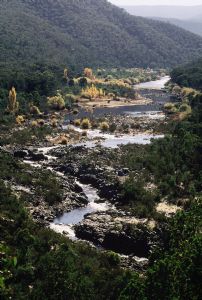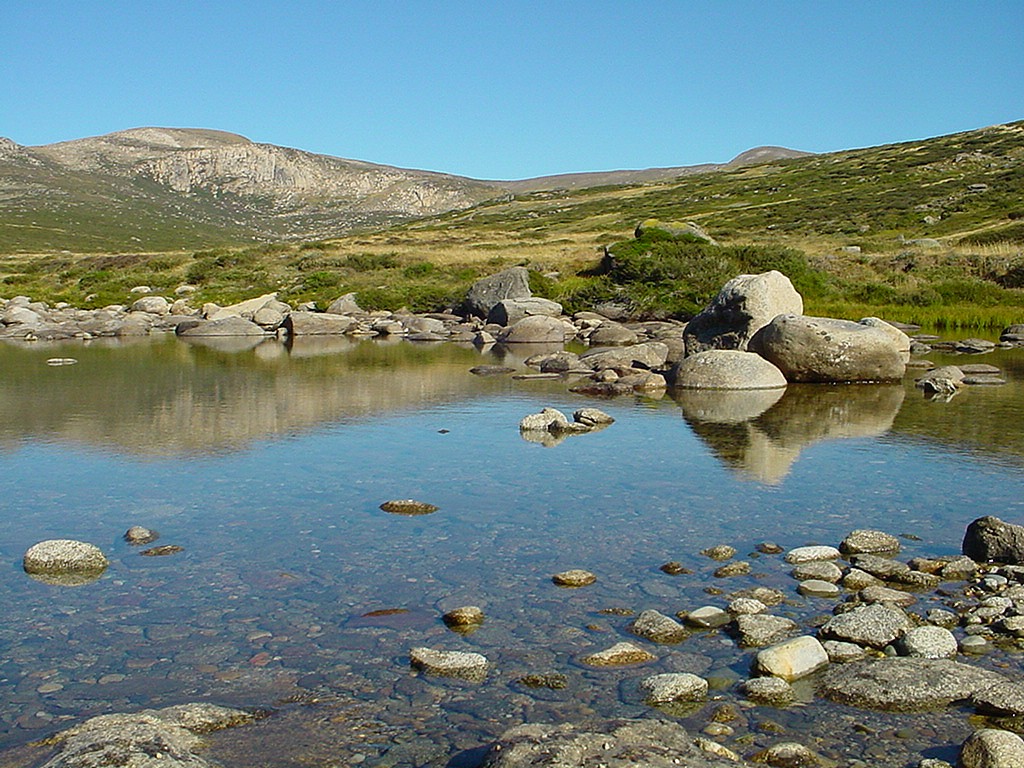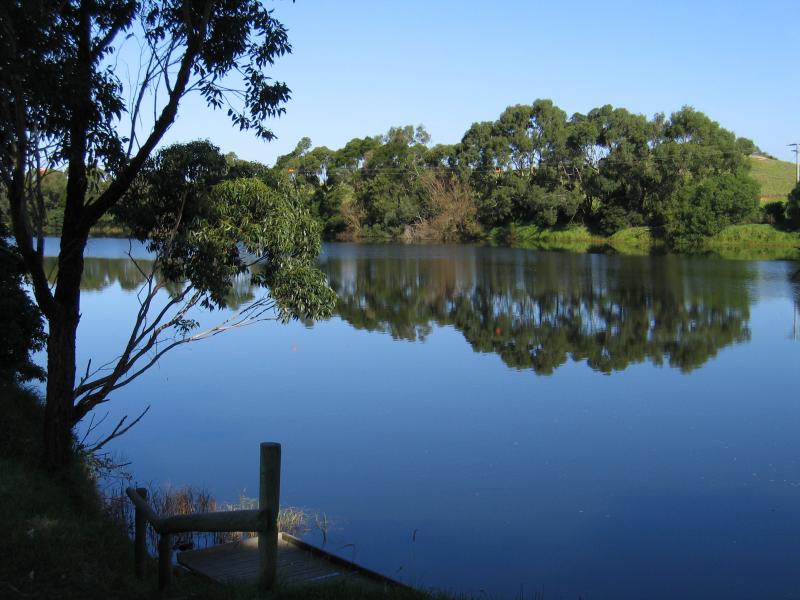Snowy River - selfish Murray River irrigators downstream continue to castrate the Snowy River
OUR (STOLEN) SNOWY RIVER

"Gone are the days
When the Snowy was a river not just a creek.
When the snow water flushed out the entire river.
When the river was deep enough to take large sized boats and ships.
When as a youngster I had picnics on the Curlip paddle-steamer up and down the Snowy River.
When the river bank had several landings to load and unload goods and produce.
When the entrance was deep enough to be safe for all who wished to use it.
The Snowy is just like a ship that has run aground.
Both are no longer able to do what was required of them.
Having lived in Orbost - Marlo all my life
It's a sad sight to see our Snowy water vanish over the hills to the other side."
- bush poem by W. B. Dreverman, born Orbost 12-1-1910.
PS. I have worked in Orbost all my life; moved from Orbost to Marlo during 1965; now retired; my wife and I enjoy looking at the ocean and the Snowy when the tide comes in. During our lives we have seen the Snowy change from a beautiful river to a sandy bottom creek.
Account by Charlie Roberson, born in 1919 at Dalgety:
"I lived one kilometre from the Snowy River for most of my life. We could always hear the Snowy singing from home. That is how I used to describe the sound of the river. It used to be quieter in the summer. Now we don't hear it at all. You wouldn't know there was a river there now.
It was a clear river most of the time, 99 per cent pure. It's hard water now. Before it was soft. The river had a gravelly sandy bed with rocks and boulders but they're overgrown now and you can't see them. During the spring thaw it used to flow for three months at least in a good strong flow, bank to bank. The level used to be up into the first ring on the pylon for that period."

...It was a very popular river for fishing. You could see the fish from the bridge. You could just about get to the river anywhere you wanted with some exceptions. Now you can hardly get to it for the weeds, willows and blackberries. When the river was dammed there was nothing to fish. There was no fish in the dams just after they were built. I have been up there and it doesn't interest me at all, especially when you've spent much of your life fishing the river. It's a different kind of fishing all together. I used to fish at night for native fish. They are all gone now. I gave up fishing when they dammed the river. "
Account by Pip Cogan, born in 1913 at Dalgety and resident 85 years, a grazier:
"The Snowy River was part of my life until it was dammed. I had fished the river since I was a young felloaction against the NSW Government for failing to honour a five-year review of the Snowy Hydro Corporation's water licence. The Alliance is arguing the legal provisions allowing the Mowamba water flow to be increased without compensationary payments.

It is clear from reading the Snowy Scientific Committee's three reports so far that the Snowy upper reaches are sick, despite the $425 million agreement in 2002 by three governments to restore it.
Sacrificed long ago to humanity's needs for hydroelectricity and irrigation water for the Murray Darling food bowl, in drought the river has become so deprived of lusty water flow that its cobbles do not turn over. Its deep pools alienate life forms, forbiddingly hot on top and cold on the bottom.
Last month the scientific committee warned the NSW Government that the limited environmental flows allowed from Snowy Hydro dams provide mere ''life support'' for plants and animals in the river."
The continued demise of the magnificent Snowy River is attributed to the political influence of the long downstream self-interested rice growers, cotton growers and citrus and grape growers, all wholly artifically dependent on irrigation from the Murray River, fed by the Snowy River upstream.
But such exploitive irrigation-dependent industries have powerful political friends like the Australian Government Rural Industries Research and Dever the way that it was and it to look at it today is simply heartbreaking."
Account by Kevin Schaefer, born 1925 at Dalgety, resident for 73 years:
"The Snowy River was a real river. In the spring the river flowed very strong after the snow melt. This strong flow existed for many months, usually from August to November. Whilst the spring was characterised by strong flows, the Snowy River could have heavy flows or flooding any time of the year.
For example the biggest flood in my lifetime occurred in the summer of 1934. All the mountain water came down here. The Snowy River's water was clean and pure. In fact when you drank it, you couldn't get enough of it.
I can remember the years between 1949 and 1956 as being particularly wet, with a peak in river flow in March 1950 when it flooded. The river could rise and fall all year round depending on the rainfall. In my lifetime I never saw the river any where near as low as it has been since the damming.
...I haven't seen the platypus like I used to. You could see colonies of platypus along the river before. Now you're lucky to see one."
The Snowy River Alliance down here in Victoria is right. Australia's most famous wild river, the Snowy River, deserves to have its natural flows restored.
The Alliance argues that if the Hydro schemers release just a third of the Snowy's original flows, its ecology could be restored. But the current life sucking 5% dished out by the Snowy Hydro Ltd corporation is exploitative, selfish and wrong.
The Snowy River Alliance, according to Glenice White of Orbost deep in Victoria's East Gippsland, started off back in 1971 as a reaction to the Snowy's "pronounced signs of degradation." This local community reaction culminated in the Snowy River Interstate Catchment Co-ordinating Committee Report, which outlined the problems of the river and its catchment and made a number of recommendations including that more water was required to improve the river's ecology.
It soon became apparent to the Snowy River community that the Snowy Hydro was steering the river's water to the irrigation agriculturalists down the Murray River, trying to artificially grow rice, citrus and grapes in an otherwise parched hot semi-arid climate. Whereas the much hyped electricity generation in reality became a small part of the operation. Instead of supplying 17% of the South Eastern Grid as the Snowy Mountains Hydro Electric Authority would want the public to believe, it supplies only 4-5%. The publicity of the Authority is not only misleading but downright wrong."
Since the Snowy Mountains Hydro Electric Scheme of the 1950s, the choice of water allocation has always been political. The construction of the Jindabyne Dam in 1967 destroyed the 150 year old local community of Dalgety, which had the Snowy running wild through the town. Dalgety's fresh water supply was reduced to a token 1% flow!
The township of Dalgety has not recovered to this day.
In 1996 a report commissioned and prepared by the NSW Department of Land and Water Conservation, Victorian Department of Natural Resources and Environment (now the Department of Sustainability and Environment) and the Snowy Mountains Hydro Electric Authority recommended that a minimum of 28% of the original flow that passed Jindabyne before the dams were built, be reinstated to the river.
A key perception problem is that Hydro industrialists argue that any water not piped to hydro-electricity or to fill dams is wasted water flow that just runs into the sea. These water industrialists reject the concept of ecological river flows as barbarian.
Then recently, the Snowy River Alliance has flagged the opening of the Mowamba River which is a headwater tributary to the Snowy. Currently, it is captured by a weir where it is whipped away via an aqueduct to Lake Jindabyne.
An article, 'Standoff over the Snowy' by Debra Jopson, 30-Jan-10, (Fairfax media) has highlighted that the Snowy River Alliance plans legal action against the NSW Government for failing to honour a five-year review of the Snowy Hydro Corporation's water licence. The Alliance is arguing the legal provisions allowing the Mowamba water flow to be increased without compensationary payments.
It is clear from reading the Snowy Scientific Committee's three reports so far that the Snowy upper reaches are sick, despite the $425 million agreement in 2002 by three governments to restore it.

Sacrificed long ago to humanity's needs for hydroelectricity and irrigation water for the Murray Darling food bowl, in drought the river has become so deprived of lusty water flow that its cobbles do not turn over. Its deep pools alienate life forms, forbiddingly hot on top and cold on the bottom.
Last month the scientific committee warned the NSW Government that the limited environmental flows allowed from Snowy Hydro dams provide mere ''life support'' for plants and animals in the river."
The continued demise of the magnificent Snowy River is attributed to the political influence of the long downstream self-interested rice growers, cotton growers and citrus and grape growers, all wholly artifically dependent on irrigation from the Murray River, fed by the Snowy River upstream.
But such exploitive irrigation-dependent industries have powerful political friends like the Australian Government Rural Industries Research and Development Corporation, the Australian Government Department of Agriculture, Fisheries and Forestry, Ricegrowers Association of Australia, SunRice, Rabobank, Westfarmers Federation Insurance, CopRice, Rice Marketing Board of NSW, Go Grains Health & Nutrition Ltd, Coleambally Irrigation, Goulburn-Murray Water, Murray Irrigation Limited, Snowy Hydro, NSW Irrigators’ Council, Snowy Mountains Engineering Corporation, the Kondinin (agricultural) Group, Cotton Australia, NSW Farmers’ Association, National Farmers’ Federation, and the Australian Rural Leadership Program, amongst others.

Recent comments